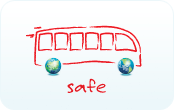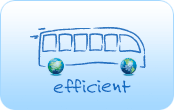|
|
|
Bus and coach terminals and stops
|
|
Bus and coach terminals and stops are the genuine “workshops” where car drivers are converted into passengers. The availability of appropriate bus and coach terminals/stations (i.e. for all cities > 50 000 inhabitants) and linking them into a network throughout Europe (as part of the Trans-European Networks) can transform them into genuine mobility interfaces for both regular and tourist travellers.
Coach stations with inter-modal exchange facilities allow larger numbers of passengers to be offered a high quality service and give added value to collective travel by bus and coach. A dense network of bus and coach stations encourages large numbers of potential travellers to opt for sustainable and safe common passenger transport. Typically, a large bus and coach terminal in a large European city welcomes on average 3-5 million passengers per year, thus contributing significantly to facilitating mobility and optimising the transport system.
Example: At the end of 2008, Stockholm’s largest bus terminal, Cityterminalen, was re-inaugurated following considerable reconstruction aimed at optimising capacity and offering travellers and passenger transport companies enhanced service. Cityterminalen is built on two levels with 19 gates. Around 100 000 buses and coaches from 500 different destinations in Sweden and the rest of Europe arrive and depart annually. Most are for scheduled long distance travel, but a considerable number are also tourist coaches.
|
|
For more information:
Stockholm City Trophy Application 2009
http://www.iru.org/index/cms-filesystem-action?file=event_2009_citytrophy/IRU-CT2009-Stockholm-Application.pdf
Study of passenger transport by coach, Final Report, European Commission, pp.64-74
http://ec.europa.eu/transport/road/studies/doc/2009_06_passenger_transport_by_coach.pdf
Study of passenger transport by coach, Appendix C: Study of coach terminals, European Commission
http://ec.europa.eu/transport/road/studies/doc/2009_06_passenger_transport_by_coach_annexe_c.pdf
|
|
Central and convenient location of bus and coach terminals
|
|
The location of bus and coach terminals is of utmost importance and highly contributes to the role of a terminal as a passenger logistics hub. Being situated next to administrative, trade, cultural and educational centres, as well as close to or integrated with railway stations, sea ports, airports and easy access to urban collective/public means of transport is a tremendous advantage. Furthermore, it should be ensured that enough space for further enlargements is available. Easy and quick access to major highways and streets, serving all directions of coach routes, is essential. The location for the construction of a coach terminal should be chosen according to short and long-term forecasting demand developments.
Example: Riga International Coach Terminal is centrally located and nowadays offers sufficient capacity. The Riga International Coach Terminal provides services to regional, long-distance and international routes. On average, it offers services to 510 local and 60 international routes per day. Every year, 5–6 million passengers pass through the terminal. Nevertheless, a new coach terminal for Riga is under construction as the increasing demand for bus and coach services and insufficient space to enlarge the coach terminal would not allow the existing terminal to operate efficiently in the future.
|
|
For more information:
Riga International Coach Terminal
http://www.autoosta.lv/main.php?lng=eng
Coach terminal as important element of transport infrastructure, Vaira Gromule, Irina Yatskiv, p. 203
http://www.tede.vgtu.lt/upload/tif_zur/2007-3-gromule_yatskiv.pdf
http://www.tsi.lv/Transport&Telecommunication/v8_en2/6.pdf
Study of passenger transport by coach, Appendix C: Study of coach terminals, European Commission
http://ec.europa.eu/transport/road/studies/doc/2009_06_passenger_transport_by_coach_annexe_c.pdf
Study of passenger transport by coach, Final Report, European Commission http://ec.europa.eu/transport/road/studies/doc/2009_06_passenger_transport_by_coach.pdf
|
|
Permanent bus and coach lanes
|
|
Permanent bus and coach lanes are dedicated to buses and coaches during the whole day. These lanes might be combined with special traffic signals which give buses and coaches complete priority and, as a result, make the bus/coach as efficient as a tram using a dedicated infrastructure. Other vehicles, such as taxis, might be allowed to use these dedicated lanes as well.
Example: Lille has introduced a high quality service bus route which has made collective/public transport popular amongst commuters and has reduced traffic in the city centre.
The combination of bus/coach lanes, priority at junctions for buses/coaches and park and ride facilities have made this possible.
Example: The city of Stockholm allows visiting tourist coaches to use dedicated public transport lines, whilst at the same time offering some 40 dedicated coach parking spaces close to touristic sites.
In Coventry (UK), Primelines is an impressive partnership project delivering high quality bus infrastructure and services to increase bus patronage across the city. It includes 5.3 km of bus lanes, plus 4.9 km of red routes, 13 new bus gates and bus bypasses to allow buses to overtake stationary traffic, 70 new bus shelters with seating and real-time information, 19 new bus stop flags with real-time information displays, and 80 new traffic signals equipped for bus priority, supported by clever marketing including personalised journey and travel planning.
In each of the Primelines corridors, research is undertaken as to how the bus reliability and journey times could be improved. Consideration is given as to whether any of the following measures could be introduced onto the corridor:
- Bus Lanes & Bus Bypasses
- Bus Priority Measures (such as bus gates)
- New Bus Stops/Shelters/Boarders
- New parking facilities and restrictions (such as red routes)
- Improved traffic signals/roundabouts
- New landscaped areas
- Improved cycling facilities
- Improved pedestrian facilities
- Provision of Real-Time Passenger Information & CCTV Cameras
Early results are impressive, showing that 47% of householders have changed their travel behaviour, 39% of householders have reduced the amount they have driven, with 24% using the bus more frequently.
|
|
For more information:
Sustainable Urban Transport, Final report from the European project Trendsetter, pp. 16-17
http://www.civitas-initiative.org/docs1/CIVITAS_TRENDSETTER_Final_Policy_Report.pdf
Lille Métropole, France – Mini-Case study, presentation by Kate Theobald, Northumbria University
http://ec.europa.eu/regional_policy/conferences/urban_rural/doc/preslille.pdf
Stockholm Visitors Board
http://www.stockholmtown.com/templates/page____17793.aspx?epslanguage=EN
Coventry
http://www.ukbusawards.org.uk/content/index.php?option=com_content&view=article&id=316&Itemid=88
http://www.coventry.gov.uk/ccm/navigation/transport-and-streets/primelines/more-about-primelines/;jsessionid=a6TOiWc5iGH5
|
|
Flexible bus/coach lanes
|
|
Flexible bus/coach lanes exist in various forms. They may be reserved for buses/coaches only during peak traffic hours or the direction of motion could change according to the main traffic flow. Such bus/coach lanes can be dedicated only to buses/coaches, or also to taxis and vehicles with more than two occupants.
Example: In 1992, Madrid introduced a 16 km flexible bus lane “BUS VAO” on a highway connecting the suburbs to the city itself. The bus lane consists of two sections. While the first section in the suburbs is for both buses and vehicles with more than two occupants, the second part, which is 3.8 km long, is only reserved for buses and coaches. The bus lane is reversible and functions according to the bigger traffic flow demand. (Morning: Suburbs-Madrid; After 14:00: Madrid-suburbs). More than 15 years of operation has proven “BUS VAO” to be an efficient service. With 21 routes, about 252 buses make use of the lane during peak hours. The share of people taking buses from the suburbs into the city centre increased from 17% in 1991 to 28% in 2007.
|
|
For more information:
Lignes Express Inter-villes et nationales, site propre autoroutier pour autobus, l’expérience espagnole
http://www.fntv.fr/IMG/pdf/LIGNES-EXPRESS_l_experience_espagnole.pdf
The intermittent bus lane system, demonstration in Lisbon
http://www.bhls.eu/IMG/pdf/intermitant_bus_lane_portugal-3.pdf
BRT in Europe: Bus of High Level of Service, Cities for Mobility World Congress, Stuttgart
http://www.cities-for-mobility.net/documents/wc08/cfm_world_congress_workshop_a_madrid.pdf
BHLS, Buses with High Level of Service
http://www.bhls.eu/
Buses with a high level of service, an opportunity for mobility in the city
http://www.bhls.eu/IMG/pdf/PlaquetteBHNS_English.pdf
|
|
Bus and coach only street
|
|
In the city of Rouen in Normandy a “BHLS” (Bus of High Level of Service) system was put in operation. Three bus lines use streets which are dedicated to bus traffic only. This allows better service and higher punctuality for customers.
|
|
Priority to buses and coaches at junctions
|
|
Through dynamic bus/coach priority systems, which give buses and coaches priority at intersections, travelling by bus and coach is getting faster. Such computer-driven systems reduce delays at traffic lights and raise the average speed.
Example: Within Trendsetter (European Environmental Project), Prague and Stockholm have introduced such systems. Experience has shown that traffic signal control needs to be an integrated part of traffic management. The city of Manchester registered an increase of 28% in bus passengers of one bus service after frequencies were doubled and bus priority measures, including at junctions, were introduced.
|
|
For more information:
Sustainable Urban Transport, Final report from the European project Trendsetter, pp. 16-17
http://www.civitas-initiative.org/docs1/CIVITAS_TRENDSETTER_Final_Policy_Report.pdf
The way ahead, bus priority, Department for Transport UK
http://www.dft.gov.uk/pgr/regional/buses/bpf/busprioritythewayahead12/rioritythewayaheadpdfversion.pdf
Moving forward, New opportunities, new passengers, CPT, pp.16-17
www.cpt-uk.org/_uploads/attachment/255.pdf
|
|
Development of guidance systems for visiting tourist coaches
|
|
Guidance systems, such as in Dresden, Bremen or in Leipzig, make it easier for visiting coach drivers to find their way around the city, by using different colours for hotels, tourist attractions and public facilities. In addition, leaflets and Internet sites, which indicate access routes and coach parking areas, facilitate the coach driver’s orientation.
|
|
For more information:
Leipzig, IRU City Trophy Award 2005
http://www.iru.org/index/cms-filesystem-action?file=en_events_2005/2005_IRUCityTrophyAward-Bewerbung-englisch.pdf, p.23
Dresden, IRU City Trophy Award 2005
http://www.iru.org/index/en_events_2005_city_trophy_dresden
Bremen, IRU City Trophy Award 2009
http://www.iru.org/index/cms-filesystem-action?file=event_2009_citytrophy/Bremen.pdf
|
|
Facilities for coach drivers
|
|
The creation of bus and coach drivers’ facilities, such as drivers’ lounges, kitchens and washing facilities, are an important step towards improving service and increasing coach tourism. Amenities of this type allow coach drivers to take a rest and prepare their own meals, i.e. while tourists explore the city.
Example: Southport (UK) has already introduced such facilities successfully, which, in combination with similar measures to welcome groups of tourists, has resulted in a record growth of coach tourism visits, including during the low tourist season, i.e. from no single coach having visited the city in January and February 1995, to more than 300 coaches in 2008.
|
|
For more information:
Southport, Application for IRU City Trophy
http://www.iru.org/index/cms-filesystem-action?file=event_2009_citytrophy/Southport.pdf
IRU – Stockholm voted most friendly coach city, http://www.iru.org/index/en_media_press_pr/code.998/lang.en
|
|
|
|
|














